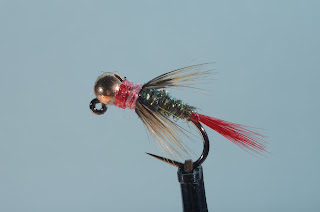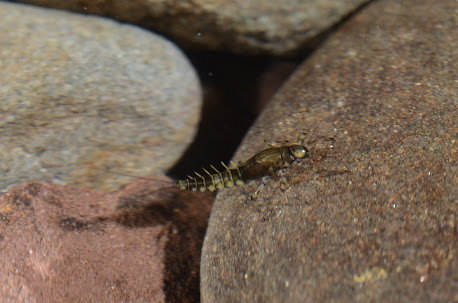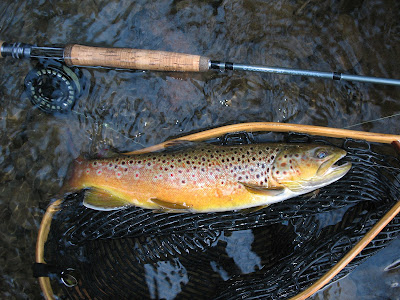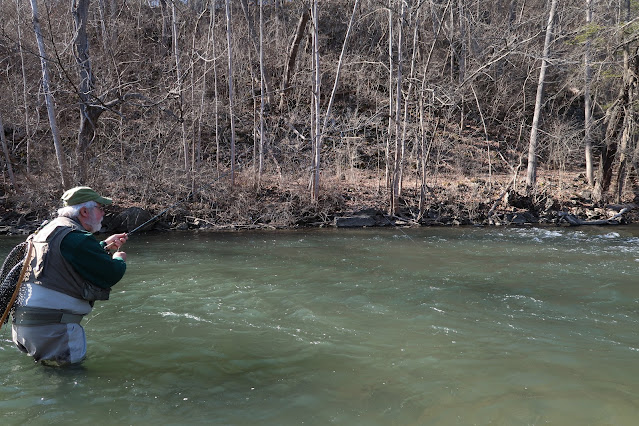Let's get one thing out of the way right now. I do not fish an all mono rig. It's just not for me. I happen to be one who likes the feel of a fly line. I feel like I have more control gripping fly line rather than mono and that's good since I happen to be a bit of a control freak. And please don't misinterpret this to mean I'm anti-all mono rig because I'm not. If it trips your trigger fire away!
And then there's this business of my being a stickler for demanding versatility in my choice of equipment. Yup, that includes a fly line. In fact, the fly line is one of the most critical components. Why so, you ask? Well, if I need to be able to switch from drifting nymphs to presenting a dry fly the line is an important component contributing to the cast. Yeah, there's something else that comes into play here but I'll cover that a bit later.
Go back a fair number of years and everything was geared to fishing tapered lines for all types of fly fishing with double tapered lines being the more popular. Yeah, there was some talk of using other lines and there was one that I recall really stood out: the rocket taper. This was the label Cortland Line put on their weight-forward lines. Since I was always thinking of delicacy in presentation I just couldn't associate rocket taper with delicacy.
For some crazy reason from the time I began fly fishing I felt that by using a fly line smaller than what was recommended I'd be presenting my flies more delicately. It's true that I didn't have a clue as to what I was doing and I had nothing to hang my hat on regarding this approach. Of course, back then a 4 weight line was a very light line and that's where I drew the line. I felt no need to go any lighter at the time. I fished everything from soup to nuts on the same line. It's just what we did.
As time passed I began fishing a 4 wt. rod with a 2 wt. weight forward line and I wanted as long a front taper as I could get. Again, think delicacy. And, yes, I fished nymphs and dries on the same set-up.
Along comes the Euro nymphing line. The vast majority of these lines are level lines with a diameter of .022". As I see it these lines are designed for one application: fishing nymphs and allowing competitor fly fishers to meet the tackle requirements for competitions. Leaders can't exceed twice the length of the rod so a fly line is a necessary component.
So, what's the big deal? While some of my friends might say I'm a fairly good caster I can't cast a dry fly with any degree of acceptability with a .022" level line! It just doesn't work for me. If I'd use a Euro line I'd be going crazy when fish would start to rise and I just don't need that kind of hassle in my life! I know that some anglers carry a second rod or, at minimum, a separate reel or reel spool to switch to something with which to present a dry. Not my cup of tea, folks. Wwaaayy too much time and effort spent switching things up. By the time I'd be ready to fish the hatch would most likely be over. Talk to my wife and she'd tell you I'm really that slow!
With versatility such an important factor for me I've had to determine how much I'm willing to compromise in my choices. As crazy as it sounds I have to defend my choices to my worst critic: ME. And here is where it may get a bit interesting...
Based on my personal fishing experience as well as talking with and observing other anglers I believe it is only the rarest of occasions that someone fishing with a sighter system has more than 4' of fly line out beyond the rod tip. Whoa, wait a minute! What about that greatest of taboos called sag?? Oh boy, here we go. My take on this is that way too much emphasis has been focused on this issue. Yeah, it's true that sag is due to weight of line and, to a much lesser extent, leader. For me, I actually find a little sag - I call it manageable sag - desirable.
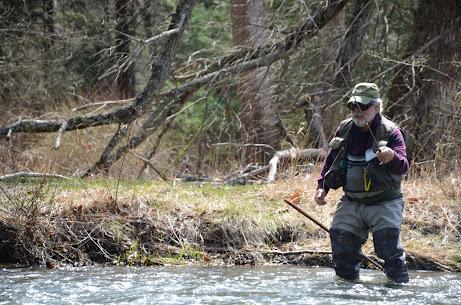
I posted on social media some time ago that I was thinking about the issue of sag relating to the fly line. Wow, did I get some "interesting" comments. Many folks commented about the all mono rig being their choice even though the post related to fly line. Of those who stuck to the issue, most felt that there's a big difference in weight between a Euro nymphing line and a tapered fly line. Unfortunately, they had no idea what I had in mind as I deliberately withheld that info. It was obvious that those who responded that way were thinking of the more popular line weights anglers typically use for fishing a variety of fly types.
So, what tapered fly line do I prefer when using a sighter system and why? First, I use the same line whether I'm fishing my 3 wt. or 4 wt. rod. It casts a dry adequately on either rod even with my longest sighter leader. The Cortland Classic Spring Creek 2 wt. serves me very well. That's right, a 2 wt. line on even a 4 wt. rod. It works.
Now, let's get into the nitty-gritty. You'll see this info is directly related to the issue of sag since the key here is how much a section of fly line actually weighs and now we go back to something I related earlier. Using the first 4 ' of fly line I weighed both the Spring Creek and a .022" Euro line. O.K., O.K., I cut the welded loops from both lines before I did anything else. Gotta get rid of those pesky, heavy, bulky loops! I weighed 1', 2', 3' and 4'. Here are the results with all weights recorded in grains.
.022" Euro line: 1' = 1.3 grains; 2' = 2.8 grains; 3' = 4.4 grains, 4' = 6.2 grains.
Cortland Spring Creek 2 wt.: 1' = 1.6 grains; 2' = 3.6 grains; 3' = 5.5 grains; 4' = 8.1 grains.
Here's where it's important to ensure we know the difference between grams and grains. There are 15.43 grains in 1 gram. Obviously, grains are the more precise measure.
And, yes, you're reading the info correctly if your mind registers the fact that there's only 1.9 grains difference in 4' of line. To put it in simple terms 1.9 grains is the equivalent of 1 1/2 bare size 10 2xl nymph hooks! Sorry to burst all those bubbles out there but, in MY mind, that difference is miniscule. Somehow I'm thinking it would take a sharp eye to discern the difference in sag between these lines especially when there's less than 4' of fly line beyond the rod tip.
What contributes to the 2 wt. coming in so close to the Euro line? It's the profile. The 2 wt. has a 4' level front tip and only begins to taper around that point. How well does this 2 wt. perform? In my hands I can present a dry out to about 60'. No reason for me to have to cast a dry any further. When you think about what it takes to switch from nymph to dry it's just a matter of taking one off and tying on another. Sure, there are times I may have to go down in tippet size but making that adjustment doesn't add much more time to the equation. And, yes, that's what I call versatility!!
When I arrive at the stream and determine that conditions would make fishing a sighter system difficult I have no problem with using an indicator. I know there are anglers out there who feel this is inferior to a sighter system; however, I'm not one of them. As I related in a previous piece I scoffed at using indicators for years until I started using them. Over time I've developed a fair amount of respect for fishing nymphs with an indicator system.
No doubt I can just put an indicator on my sighter leader and fish and I do that now and again. It's definitely a viable option; however, I choose a different route when I know I'll be fishing an indicator system from the get-go. Oh, yeah, this system meets my requirement for versatility quite well, too.
When I choose a line geared toward casting the additional weight of an indicator or, in the case of an indicator which provides air resistance when casting I want a line that's front-loaded. Now, some of you may be wondering what in the world do I mean by front-loaded? A line having a short taper puts more of the weight of the line toward the tip of the fly line. Hence, when there's more line weight toward the tip the line is front-loaded. This aids in turning over the indicator's weight/resistance to casting...at least somewhat. Here's another compromise on my part. While some additional fly line weight is acceptable and may even be desirable I still use a very light fly line. For this application I'm using a Cortland Trout Boss Double Taper 2 wt. This is about the time some who read this begin to chuckle and say, wait a minute. You want more weight and you still use a 2 wt. line?? That's hilarious!! Chuckle you may but in the end it works! Yup. First, it's not a true 2 wt. A 2 wt. line should weigh 80 grains plus or minus. And that's in the first 30' of line, of course. This line weighs 100 grains. Isn't it interesting that a 3 wt. is supposed to weigh 100 grains. So much for what we're seeing in the world of fly lines these days. Too, this line has a 6' long taper which is a bit shorter than the average. So, yes, it does give me some additional weight which is enough for most of what I want it to do. Of course, I use a totally different leader system when fishing this line with an indicator. I'll cover that in a bit. Oh, hey, before I forget let's get rid of the welded loop on this line, too. It doesn't help and in fact it's flat out a pain.
Now that I've established my choices for fly lines for fishing nymphs - and more - and the reasoning behind them it's time to move on to leaders. There's been an interesting...I'll call it evolution...in thought and application regarding leaders for nymphing and I'm sure that many - perhaps even most - anglers would agree. When I say this I'm referring to sighter leaders. In contrast, leaders for fishing indicators don't seem to get anything beyond the most insignificant attention these days; here, however, I'll be covering them both.

When I was first introduced to a sighter leader I thought, "hey, now that's pretty nifty!" I could actually see what was going on with my drift and the visual feedback was wild! Of course, when you're reading this and picturing in your mind what I may have experienced back in the mid-70's is most likely different from what I had. While we used Maxima Chameleon mono for some leaders the sighter leader I began using used something different. Think of a mono that's much more visable. If for some crazy reason Stren fluorescent clear blue spinning line popped into your mind you'd be right on the money. And yes, it's what I still use today.
There are some significant differences between Maxima and Stren. Let's look at Maxima Chameleon first. I think we'd all agree it isn't easy to see and that means it makes following any part of a leader tied with it very difficult at best. I'm one who kinda' likes to see as much of my leader as possible when I'm focused on watching my drift. The more feedback I can get the better it is for me to detect any abnormality in my drift.
Another characteristic of this material is that it is stiff. I've always felt that stiff mono doesn't transmit "feel" as well as soft mono. Think about that. With the emphasis on "feel" or sensitivity nowadays I've often wondered how much thought most anglers have given to how it might play in leader material. I've said it before and I'll say again I believe there's way too much emphasis placed on feel or sensitivity; however, for those who count it important this gives them something to ponder.
Finally, there's this business of diameter. For the most part it's how we relate to the size of the material we use to construct our leaders. Now, I'm one of these folks who questions most everything. I like to know what I have and use. Same goes for leader material. My experience with Maxima Chameleon is that when I put it to the micrometer test it ain't what it's supposed to be. This stuff pretty much runs .002" larger than it's labeled. That's a lot in my book. Maxima tells us this material is more abrasion resistant. Well, when you have that much more material than what I've been led to believe it will be so!
Let's go a little deeper with this diameter issue as it relates to Maxima Chameleon. Some leaders start out with 20 lb. test which is labeled as .017". Many anglers who aren't using one of those micro leaders tend to use what I call a "middle of the road" butt section of 12 lb. test which is shown as .013". Add .002" to these diameters and let's go from there. It's true that I would/could not use a butt section of .013" because it wouldn't do well when casting a dry fly and that makes it unacceptable. A .015" butt section is a whole different ballgame. Even so, I still wouldn't use Maxima.
Now, let's consider the characteristics of Stren fluorescent clear blue mono. First, it's visible. It gives me feedback and that's a positive. Second, it's soft. Should transmit "feel" a bit better. Third, it runs fairly true to labeled diameter when put in a micrometer. How 'bout that! Using my rating system it beat out Maxima in the three important categories. I'll take it!!
I almost hesitate to even mention the more recent interest in micro leaders. Can't cast a dry fly with one so no more needs to be said.
Do I have more than one sighter leader formula? Yup. Why, you ask? Well, over time I've experimented and I've just kept the formulas. Now, for small streams not only will I use a shorter rod I'll also use a shorter leader. One interesting note is that I've offered a leader to some folks in the industry and I was surprised when they indicated a preference for a shorter leader. Personally, I find it aggravating when someone only talks in generalities like longer and shorter like I just did. So, for clarity my longest (and most frequently used) leader will measure up to 20' to my shot when I'm rigged for fishing two nymphs. The short leader will be around 11' to 12' to the shot. When I use the short leader I'm usually fishing only one fly and I'm fishing smaller water.
There's an old standard guide for constructing leaders: 60% butt section, 20% mid-section and 20% tippet. It's a guide and believe me when I say I stretch it to the limit. True, all things have their limit but I'm always pushing it. Here are two of my leader formulas with one representing the longest and the other the shortest.
.018" (20 lb. Blue Stren) - 26"
.016" (17 lb. Blue Stren) - 22" 86"
.014" (14 lb. sighter mtl) - 16" 22"
.013" (12 lb. Blue Stren) - 12" 18"
.011" (any sighter matl) - 10" 14"
.009" (matl of choice) - 8" 12"
Below 2X (.009") I use about 60" of 4X (.007") and that's about as low as I go. For years I'd go down to 6X (.005") and every once in a while 7X (.004"). I've determined there's no need to go lower than 4X after I really gave some thought to what goes on with a tippet drifting through the current with weight attached at the bottom. It's not at all akin to drifting an unweighted fly on the surface. And then there's the fact that trout aren't leader diameter shy; however, they are leader drag shy.
Here are some additional factors I've had to consider when determining what I use. First, I don't use fluorocarbon. I think I'm starting to hear some rumbling about now and it isn't my tummy reacting to what I ate for dinner. I won't repeat myself because you read it right the first time. Why, you ask? Because I don't believe the potential benefit - and I believe there may be only one - isn't worth the cost. It's a heck of a lot more expensive than nylon monofilament. Yes, it's heavier than water and that means it sinks. Hey, once mono absorbs water it becomes neutral buoyant. Not a problem. And now for the biggy. Fluorocarbon is stiffer than mono. While I'm not saying it's impossible to convince me otherwise I'm not so sure that the increase in stiffness over mono may just negate the idea of the finer diameter providing any benefit as the tippet rides through the current. Just a thought... But it's enough to bring me to the point where, as indicated earlier, I rarely go below 4X in contrast to those who regularly fish 6X or 7X. So, what's the one benefit fluorocarbon may have? Abrasion resistance...maybe.
One thing I discovered as I looked at some of the new mono offerings out there. When I put a micrometer to them it became apparent as to why they're so much stronger than the standard stuff: some are up to .002" larger diameter than what they are labeled. If I want 4X I want 4X, not 2X!
Now that I've covered my sighter leader approach we can move on to what I use when I fish an indicator system. Sure, in a pinch I can just add an AirLock indicator and I do just that. Most times when I get to the stream I know right from the start it's not a day for a sighter system and out comes my reel with the double taper line with a leader I find more suited to fishing an indicator.
Here's where I do almost a 180. Rather than constructing an entire leader I start off with a standard knotless 3X or 4X tapered leader and most of the time it's a 9 footer. I cut the leader back about 1 1/2' from the tippet end, tie a very small perfection loop and attach a section of 4X about 5' long. I want this long tippet with no knots at least 3' down from the connection with the knotless leader. One of the indicators I like to use doesn't play well with knots and I need to reposition the indicator as I encounter different depths and current speeds. A small change can make a big difference at times.
When it comes to adding my nymph(s) and weight I do it the same whether I'm using a sighter or indicator system. I'll cover specifics in a later article. Oh, and let's not forget that all of these leaders will turn over a dry fly. Versatility!!
So, there we have MY approach to lines and leaders. Under no circumstances would I say my choices and reasoning are superior to anyone else's. It all boils down to knowing what we like and having confidence in our choices. It helps if the results we see satisfy our expectations, as well.
Next up: Flies, accessories an a bit more on rigging. Stay tuned!
.

